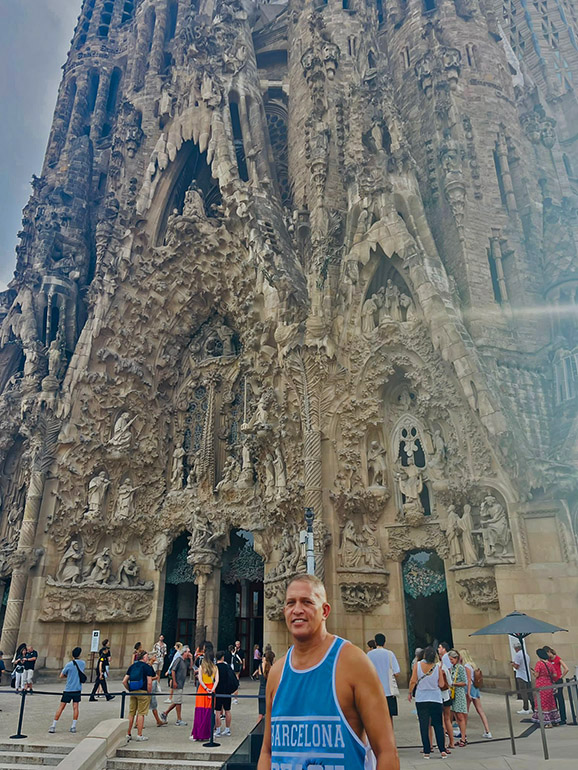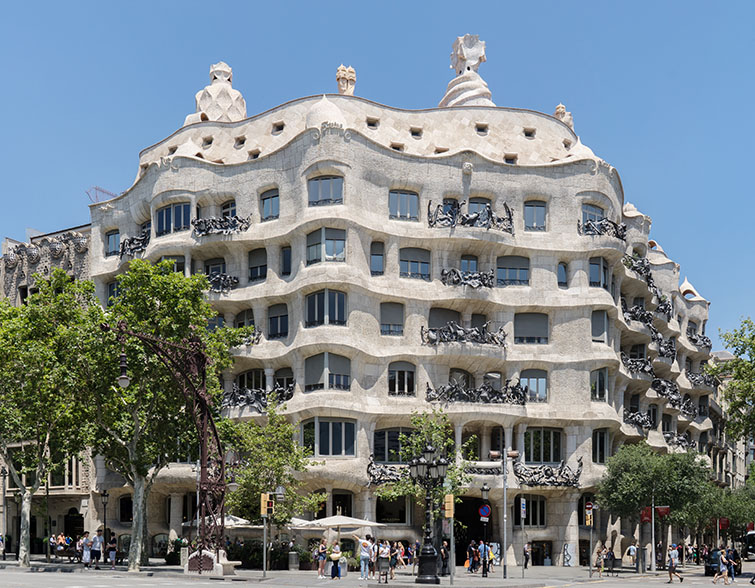
Lenny Dorsey visiting Sagrada Familia, the most popular Barcelona Attraction; (c) Soul Of America
Barcelona Attractions
Sagrada Família
An unfinished Catholic church in the Eixample district highlights Barcelona Attractions. It is the largest unfinished Catholic church in the world. Designed by architect Antoni Gaudí, his work on Sagrada Família is part of a UNESCO World Heritage Site. On 19 March 1882, construction of the Sagrada Família began under architect Francisco de Paula del Villar. In 1883, when Villar resigned, Gaudí took over as chief architect, transforming the project with his architectural and engineering style, combining Gothic and curvilinear Art Nouveau forms. Gaudí devoted the remainder of his life to the project, and he is buried in the church’s crypt. At the time of his death in 1926, less than a quarter of the project was complete. Relying solely on private donations, the Sagrada Família’s construction progressed slowly and was interrupted by the Spanish Civil War. In July 1936, anarchists from the FAI set fire to the crypt and broke their way into the workshop, partially destroying Gaudí’s original plans. MAP
Park Güell
A private park composed of gardens and architectural elements on Carmel Hill, which belongs to the mountain range of Collserolae. Park Güell is located in La Salut, a neighborhood in the Gràcia district. With urbanization in mind, Eusebi Güell assigned the design of the park to Antoni Gaudí, a renowned architect and the face of Catalan modernism. The park was built from 1900 to 1914 and was opened as a public park in 1926. In 1984, UNESCO declared the park a World Heritage Site. Daily 9:30am-7:30pm MAP
Casa Milà
A Modernista building that was the last private residence designed by architect Antoni Gaudí and was built between 1906 and 1912. At the time, it was controversial because of its undulating stone facade, and twisting wrought iron balconies designed by Josep Maria Jujol. Several structural innovations include a self-supporting stone façade, a free-plan floor, an underground garage, and a spectacular terrace on the roof. In 1984, it was declared a World Heritage Site by UNESCO. Since 2013 it has been the headquarters of the Fundació Catalunya La Pedrera, which manages visits to the building, exhibitions, and other cultural and educational activities at Casa Milà. Daily 9am-11pm MAP
Barcelona Arc de Triomf
A triumphal arch in the city of Barcelona in Catalonia, Spain. It was built for the 1888 Barcelona World Fair. The arch crosses over the wide central promenade of the Passeig de Lluís Companys, leading to the Ciutadella Park. It is located at the northern end of the promenade, facing the Passeig de Sant Joan. MAP
Mercat de Sant Josep de la Boqueria
Often called La Boqueria, is a large public market in the Ciutat Vella district of Barcelona, Catalonia, Spain, and one of the city’s foremost tourist landmarks, with an entrance from La Rambla, not far from the Liceu, Barcelona’s opera house. The market has a very diverse selection of goods. Daily 8am-8:30pm MAP
Palau de la Música Catalana
A concert hall designed in the Catalan modernista style by the architect Lluís Domènech i Montaner, it was built between 1905 and 1908 for Orfeó Català, a choral society founded in 1891 that was a leading force in the Catalan cultural movement that came to be known as the Renaixença. Financed mostly by Barcelona’s wealthy industrialists, it opened in 1908. Between 1982 and 1989, the building underwent extensive restoration & remodeling. In 1997, the Palace de la Música Catalana was declared a UNESCO World Heritage Site along with Hospital de Sant Pau. Today, more than half a million people a year attend musical performances in Palau that range from symphonic and chamber music to jazz and Cançó. Daily 9am-8pm MAP
Barcelona Cathedral
A Gothic cathedral and seat of the Archbishop of Barcelona, Catalonia, Spain. The cathedral was constructed from the 13th to 15th centuries. The cloister, which encloses the Well of the Geese, was completed in 1448. In the late 19th century, the neo-Gothic façade was constructed over the nondescript exterior that was common to Catalan churches. The roof is notable for its gargoyles. Its form is pseudo-basilica, vaulted over five aisles, the outer two divided into chapels. The transept is truncated. The east end is a chevet of 9 radiating chapels connected by an ambulatory. The high altar is raised, allowing a clear view into the crypt. The cathedral is dedicated to Eulalia of Barcelona, co-patron saint of Barcelona, a young virgin who, according to Catholic tradition, suffered martyrdom during Roman times in the city. Daily 8am-7:30pm MAP

Casa Mila designed by Barcelona architect Antonio Gaudi; credit Thomas Ledl
La Rambla
A tree-lined pedestrian street that stretches for 3/4 mile connecting the Plaça de Catalunya in its center with the Christopher Columbus Monument at Port Vell. La Rambla forms the boundary between the neighborhoods of the Barri Gòtic to the east and the El Raval to the west. La Rambla can be crowded, especially during the height of the tourist season. Its popularity with tourists has affected the character of the street, which has shifted in composition to pavement cafes and souvenir kiosks. It has also suffered from the attention of pickpockets. Open 24 hours MAP
The Magic Fountain of Montjuïc
An immaculate fountain located at the head of Avinguda Maria Cristina in the Montjuïc district below the Palau Nacional on the Montjuïc mountain. Like most of the surrounding developments, the fountain was constructed for the 1929 Barcelona International Exposition. The fountain sprays 700 gallons of water a second through 3620 jets to create its effect. The highest water spout is 170 feet. Tue-Sun 11am-1pm, 4pm-6pm MAP
Basilica of Santa Maria del Mar
A grand Catholic church in the Ribera district was built between 1329 and 1383 at the height of Catalonia’s maritime preeminence. It is an outstanding example of Catalan Gothic, with a purity of style that is very unusual in large medieval buildings. Daily 9am-8:30pm MAP
Parc de la Ciutadella
Located on the northeastern edge of Ciutat Vella district. For decades following its creation in the mid-19th century, this park was the city’s only green space. The grounds include the city zoo, the Palau del Parlament de Catalunya, a small lake, museums, and a large fountain. As the location of the Parliament of Catalonia, the tensions in 2018 and 2019 regarding Catalan independence regularly led to the police closure of the park to public access. Daily 10am-10:30pm MAP
Plaça de Catalunya
This large square is generally the place where Old City and the 19th-century-built Eixample meet. Some of the city’s most important streets and avenues meet here: Passeig de Gràcia, Rambla de Catalunya, La Rambla, and Portal de l’Àngel. It is known for its fountains and statues, and its proximity to some of Barcelona’s most popular attractions. The square played a significant part in the Spanish Civil War, in particular as a site of key events of the May Days. Open 24 hours daily MAP
